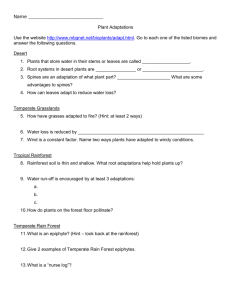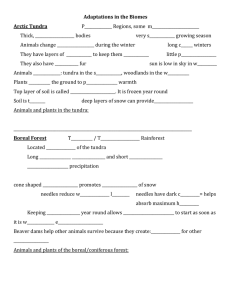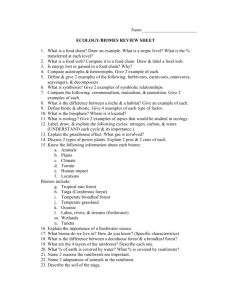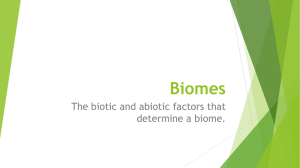Second-year Test in ecology (with answers) February 2005
advertisement
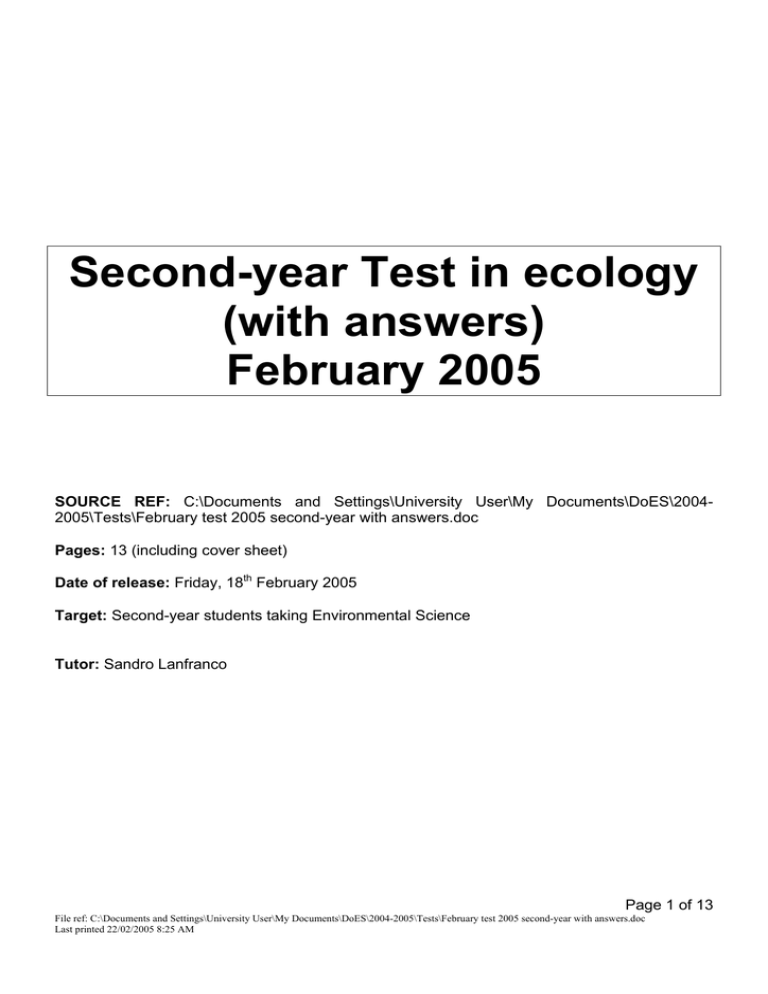
Second-year Test in ecology (with answers) February 2005 SOURCE REF: C:\Documents and Settings\University User\My Documents\DoES\20042005\Tests\February test 2005 second-year with answers.doc Pages: 13 (including cover sheet) Date of release: Friday, 18th February 2005 Target: Second-year students taking Environmental Science Tutor: Sandro Lanfranco Page 1 of 13 File ref: C:\Documents and Settings\University User\My Documents\DoES\2004-2005\Tests\February test 2005 second-year with answers.doc Last printed 22/02/2005 8:25 AM UNIVERSITY OF MALTA GF Abela Junior College Msida - Malta SECOND YEAR MID-SEMESTER TESTS February Session 2005 Environmental Science February 2005 Time: 45 minutes _________________________________________________________________ Directions to Candidates • You are required to answer ALL questions in this test. • Each correct answer carries one mark. No marks shall be deducted for incorrect answers. • The use of electronic calculators is permitted. • Answers to Section A should be filled in on the attached answer sheet. Answers that you consider to be correct should be indicated by a 3 symbol in the appropriate space in the answer sheet. • Should an answer be erroneously indicated as correct, the entire space so indicated is to be filled in with solid colour. The space corresponding to the correct answer should subsequently be indicated. ____________________________________________________________________________ Page 2 of 13 1. Endangered species are generally: a) specialists b) highly fertile c) generalists d) none of the above. 2. Interspecific competition means a) Competition between specific predators b) Organisms of different species competing for a limiting resource c) Organisms of the same species competing for a limiting resource d) none of the above 3. The role and relationships of an organism in its ecosystem is referred to as: a) ecological niche b) ecotone c) habitat d) biome 4. Secondary succession occurs on: a) volcanoes b) land that has been fertilised c) land previously unoccupied by vegetation d) land previously occupied by vegetation 5. Certain night-active moths and day-active birds are specialised nectar feeders. How do these species coexist if they are using the same resource for food? a) Since they both use the nectar eventually one of the two species will need to move to a new area. b) They do not compete for the nectar because they feed at different times of the day. c) There is enough nectar to supply both the birds and the moths with their feeding needs. d) Eventually the niche breadth will increase and there will be less competition. 6. A Titmouse and a Chickadee are living in the same territory and are using some of the same resources. The best way to classify this interaction is as a) mutualism. b) intraspecific competition. c) interspecific competition. d) symbiosis. 7. In a commensal relationship, a) one species benefits while the other neither suffers nor benefits. b) one species benefits while the other suffers. c) two species live together but both suffer. d) one species suffers while the other neither suffers nor benefits. 8. In an amensal relationship, a) one species benefits while the other neither suffers nor benefits. b) one species benefits while the other suffers. c) two species live together but both suffer. d) one species suffers while the other neither suffers nor benefits. Page 3 of 13 9. 10. 11. In a biological community where diversity is great, such as a tropical rainforest, the abundance of any one species is likely to be a) great. b) small. c) widely variable from year to year. d) the same from year to year. As a rule, near the Earth's north and south poles, a) diversity is great, while abundance is low. b) abundance is great, as is diversity. c) neither abundance nor diversity is great. d) abundance is great, but diversity is low. Primary succession occurs when a community develops ____________ while secondary succession occurs when one ________. a) into a climax community, species replaces another b) and replaces another, ecosystem becomes stable c) on unoccupied ground, biological community replaces another d) and then fails, niche changes 12. A climax community is one that a) is relatively stable and long-lasting. b) lasts forever. c) contains oaks or White Spruce. d) is impervious to disruption. 13. The effect of competition on an ecological niche is: a) It relaxes the niche b) It enlarges the niche c) It compresses the niche d) Competition has no effect on ecological niches 14. Ecological release refers to: a) The return of a niche to its original size following the removal of competitors b) The return of a niche to its original size following the introduction of competitors c) The compression of a niche following the introduction of competitors d) The compression of a niche following the removal of competitors 15. Populations are most critically limited by a) Available food. b) Available water. c) Suitable shelter from the elements. d) Any of these, depending on the system. 16. The word "niche" refers to an organism's _______ while its habitat refers to _________. a) Environmental surroundings, its cumulative tolerance limits b) Cumulative tolerance limits, its environmental surroundings c) Role and relationships in its community, its environmental surroundings d) Life cycle within its population, its role and relationships in its community Page 4 of 13 17. A generalist is a species that a) Occupies a large habitat range. b) Occupies a variety of ecological niches. c) Can reproduce under highly variable conditions. d) All of these are characteristics of a generalist species. 18. Humans can best be described as a) Occupying a narrow niche. b) An example of convergent evolution. c) Generalists. d) Outside the rules of natural selection. 19. A common strategy for successful interspecific competition is a) Eating prey before they are "ready" (ripe) for other species. b) Spreading seeds or offspring far and fast. c) Producing substances that are toxic to competitors. d) All of these are strategies for successful interspecific competition. 20. An especially effective strategy for reducing intraspecific competition is a) Different ecological niches for juveniles and adults. b) Rapid reproduction. c) Eating prey before they are "ready" (ripe) for other species. d) Resource partitioning. 21. Residence time of water in oceans is a measure of the a) Age of the oceans. b) Average amount of time a water molecule spends in the ocean. c) Average amount of time needed for the entire ocean to be replaced by rainfall. d) Time an average water molecule spends in one region before it circulates to another. 22. A relationship where one organism feeds on another organism of a different species after having killed it is called: a) Parasitism b) Predation c) Cannibalism d) Metamorphism 23. In nature, most populations are a) In a dynamic state of equilibrium. b) Stable most of the time. c) Increasing most of the time. d) Always undergoing fluctuations. 24. Which of the following sequences is an example of arithmetic growth rate? a) 2, 4, 8, 16 b) 1, 2, 4, 8 c) 1, 3, 5, 7 d) 3, 6, 12, 24 Page 5 of 13 25. Which of the curves above represents exponential growth? a) A b) B c) C d) D 26. Which of the curves above represents arithmetic growth? a) a b) b c) c d) d 27. An organism's biotic potential is the maximum number of offspring a) that it can produce. b) that survive to adulthood. c) its habitat can support. d) it produces at one time. 28. A population explosion is usually followed by a) continuous high population levels. b) a gradual decrease as food supplies dwindle. c) a tremendous flowering of genetic diversity. d) a population crash. 29. A dieback, or population crash, often occurs after a species ________ its environmental carrying capacity. a) Meets b) Undershoots c) Overshoots d) oscillates around 30. A relationship where one organism feeds on another organism of a different species without killing it is called: a) Parasitism b) Predation c) Cannibalism d) Metamorphism Page 6 of 13 31. Which of the following types of population curves would best represent a group of rabbits that enter a new, open habitat, and become a stable part of that ecosystem? a) exponential curve b) irruptive growth curve c) J-shaped curve d) S-shaped curve 32. In the population oscillation graph above, the dieback phase is marked by the letter a) A b) B c) C d) D 33. In the population oscillation graph above, the exponential phase is marked by the letter a) A b) B c) C d) D 34. In the population oscillation graph above, the overshoot is marked by the letter a) A b) B c) C d) D 35. The horizontal line on the above population oscillation graph represents a) carrying capacity. b) biotic potential. c) predator populations d) arithmetic growth. 36. Carrying capacity is the population a) of a species without predators b) that a species' environment can support on a long-term basis. c) that remains after a catastrophic dieback has occurred. d) that an environment can support in an optimal year. Page 7 of 13 37. Which of the following is the correct equation? a) carrying capacity + environmental resistance = biotic potential b) biotic potential + environmental resistance = carrying capacity c) biotic potential - environmental resistance = carrying capacity d) carrying capacity - environmental resistance = biotic potential 38. Logistic growth rates are those in which a population a) grows very slowly when conditions are good as well as when they are not good. b) grows rapidly when conditions are good, then slows down as it approaches carrying capacity. c) overshoots and dies back repeatedly. d) remains significantly below carrying capacity. 39. Factors that limit growth and produce population equilibrium are known as a) predation resistance. b) environmental resistance. c) diebacks. d) biotic potential. 40. Density-independent population control factors cause mortality a) when the population becomes too large. b) regardless of population size. c) when the population becomes too small. d) when the density becomes too low. 41. Widespread starvation is an example of _________ population control. a) predator-caused b) biotic c) density-dependent d) density-independent 42. Which of the following is an abiotic population control? a) Predation b) Disease c) water shortages d) prey shortages 43. 44. In general, abiotic regulatory factors tend to be ___________ while biotic factors tend to be _____________. a) interspecific, intraspecific b) intraspecific, interspecific c) density-dependent, density-independent d) density-independent, density-dependent Which of the following is an intraspecific interaction? a) competition for water resources b) territoriality c) parasitism d) predation Page 8 of 13 45. Emigration can benefit a species because it a) provides insurance against population loss in the home territory. b) can relieve stress. c) allows the species to take advantage of more resources. d) All of these can benefit a species. 46. In the population graph above, human population growth most closely resembles a) carrying capacity geometric increase. b) irruptive growth. c) S-shaped growth curve. d) J-shaped growth curve. 47. In the population graph above, the Industrial Revolution is most closely marked by the letter a) A b) B c) C d) D 48. In the population graph above, the plague is most closely marked by the letter(s) a) A b) between b and c. c) c. d) between c and d. 49. The earliest humans were probably: a) Farmers b) Fred, Wilma, Barney and Betty c) Hunter-gatherers d) Industrialised 50. Ninety percent of the world's population growth in the next century is expected to occur in a) less-developed countries. b) China. c) developed countries. d) moderately-developed nations. Page 9 of 13 51. Crude birth rates are measured in terms of the number of children born a) in a single year. b) per family. c) per 1000 people in the general population. d) per 1000 people each year. 52. Crude birth rates are statistically "crude" because they do not account for a) pertinent population characteristics such as the number of reproductive women. b) the relative number of deaths occurring in a year. c) the total size of the population. d) the births of illegal immigrants. 53. The main cause of world population growth in the past 300 years has been a) increasing fecundity. b) rising fertility. c) falling mortality. d) increasing immigration. 54. The population represented by the age class histogram on the right (above)will a) have a large population of old people soon. b) not grow much in the coming years c) begin to shrink in the next few years as old people die in greater numbers. d) continue to grow substantially in the future. 55. The age class histogram on the right(above), could represent the population of a) the United States. b) Sweden. c) Mexico. d) None of these. 56. The age class histogram on the left (above), could represent the population of a) the United States. b) Sweden. c) Mexico. d) None of these. 57. The left-hand histogram above represents a population whose birth rates a) have not changed for many years. b) have recently decreased. c) are gradually increasing. d) are sharply increasing. Page 10 of 13 58. The demographic transition refers to a country's change from a) high birth and death rates to low birth and death rates. b) high to low birth rates and low to high death rates. c) a majority of elderly people to a majority of healthy young people. d) development and power to underdevelopment. 59. A demographic transition is expected to accompany a) colonization, as in Africa and Asia. b) economic development and stabilization. c) the development of capitalism. d) the introduction of modern medicine. 60. Many demographers believe that birth rates will fall as development proceeds because a) child raising becomes more expensive. b) people are better educated and have more economic options. c) women begin to have more influence in family planning. d) All of these. 61. Which of these biomes is characterised by permafrost, a short growing season and no trees? a) Savannah b) Scrubland c) Tundra d) Desert 62. Which of these biomes is characterised by a dry climate and seasonal and diurnal extremes of temperature? a) Savannah b) Scrubland c) Tundra d) Desert 63. Which of these biomes can be formed as a result of descending air masses approximately 30° north or south of the equator? a) Savannah b) Scrubland c) Tundra d) Desert 64. 65. Which of these biomes is dominated by grasses? a) Savannah b) Scrubland c) Tundra d) Desert Which of these biomes are inhabited by animals with thick layers of fat and thick coats of fur? a) Savannah b) Scrubland c) Tundra d) Desert Page 11 of 13 66. Which of these biomes is characterised by hot, dry summers and cold, wet winters? a) Savannah b) Scrubland c) Tundra d) Desert 67. Which of these biomes is characterised by abundant shrubs and scattered trees? a) Savannah b) Scrubland c) Tundra d) Desert 68. Which of these biomes are dominated by cacti and succulent plants? a) Savannah b) Scrubland c) Tundra d) Desert 69. In which of these biomes are lichens, sedges mosses and small shrubs the dominant vegetation? a) Savannah b) Scrubland c) Tundra d) Desert 70. In which of these biomes would you expect a waterlogged soil during the summer season? a) Savannah b) Scrubland c) Tundra d) Desert 71. In which biome would you expect to come across very poor, acidic soils? a) Tropical rainforest b) Sclerophyllous forest c) Temperate deciduous forest d) Temperate evergreen forest 72. Which of these biomes is dominated by relatively small trees with small, leathery leaves? a) Tropical rainforest b) Sclerophyllous forest c) Temperate deciduous forest d) Temperate evergreen forest 73. Which of these biomes are characterised by several, very tall trees whose crowns form a closed canopy? a) Tropical rainforest b) Sclerophyllous forest c) Temperate deciduous forest d) Temperate evergreen forest Page 12 of 13 74. Which of these biomes are characterised by least seasonal variation in climate? a) Tropical rainforest b) Sclerophyllous forest c) Temperate deciduous forest d) Temperate evergreen forest 75. In which of these biomes are plants sometimes dormant during the summer months? a) Tropical rainforest b) Sclerophyllous forest c) Temperate deciduous forest d) Temperate evergreen forest 76. In which of these biomes do trees shed their leaves during winter? a) Tropical rainforest b) Sclerophyllous forest c) Temperate deciduous forest d) Temperate evergreen forest 77. In which of these biomes would you expect to find trees with needle-shaped leaves? a) Tropical rainforest b) Sclerophyllous forest c) Temperate deciduous forest d) Temperate evergreen forest 78. In which of these biomes would you expect very poor undergrowth? a) Tropical rainforest b) Sclerophyllous forest c) Temperate deciduous forest d) Temperate evergreen forest 79. In which of these biomes would you expect to find pine trees? a) Tropical rainforest b) Sclerophyllous forest c) Temperate deciduous forest d) Temperate evergreen forest 80. In which of these biomes would you expect to find olive trees? a) Tropical rainforest b) Sclerophyllous forest c) Temperate deciduous forest d) Temperate evergreen forest Page 13 of 13
